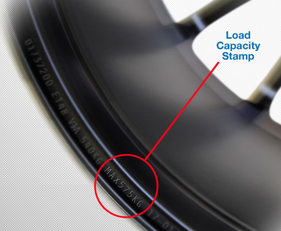
The tyre load index, also known as the load capacity index or tyre load rating, indicates the maximum weight that a tyre can safely carry. It is represented by a numerical value found on the sidewall of the tyre. The higher the load index, the greater the weight the tyre can support. Understanding the load index is essential for selecting tyres that can adequately handle the weight requirements of your vehicle. By adhering to the load index specifications, you ensure optimal safety and performance.
The load rating, load index or load carrying capacity is represented by a numerical code and is associated with the maximum load that the tyre can carry when operating at its maximum speed rating up to but not exceeding 210kph.
When replacing tyres please note that it is illegal to install tyres on a vehicle having a lower load index than the vehicle manufacturer's original tyre fitment.
Tyre Load Index Table
| Load Index Table: | |||||||||||
|---|---|---|---|---|---|---|---|---|---|---|---|
| LI | KG | LI | KG | LI | KG | LI | KG | LI | KG | LI | KG |
| 0 | 45 | 10 | 60 | 20 | 80 | 30 | 106 | 40 | 140 | 50 | 190 |
| 1 | 46.2 | 11 | 61.5 | 21 | 82.5 | 31 | 109 | 41 | 145 | 51 | 195 |
| 2 | 47.5 | 12 | 63 | 22 | 85 | 32 | 112 | 42 | 150 | 52 | 200 |
| 3 | 48.7 | 13 | 65 | 23 | 87.5 | 33 | 115 | 43 | 155 | 53 | 206 |
| 4 | 50 | 14 | 67 | 24 | 90 | 34 | 118 | 44 | 160 | 54 | 212 |
| 5 | 51.5 | 15 | 69 | 25 | 92.5 | 35 | 121 | 45 | 165 | 55 | 218 |
| 6 | 53 | 16 | 71 | 26 | 95 | 36 | 124 | 46 | 170 | 56 | 224 |
| 7 | 54.5 | 17 | 73 | 27 | 97.5 | 37 | 127 | 47 | 175 | 57 | 230 |
| 8 | 56 | 18 | 75 | 28 | 100 | 38 | 130 | 48 | 180 | 58 | 236 |
| 9 | 58 | 19 | 77.5 | 29 | 103 | 39 | 133 | 49 | 185 | 59 | 243 |
| 60 | 250 | 70 | 335 | 80 | 450 | 90 | 600 | 100 | 800 | 110 | 1060 |
| 61 | 257 | 71 | 345 | 81 | 462 | 91 | 615 | 101 | 825 | 111 | 1090 |
| 62 | 265 | 72 | 355 | 82 | 475 | 92 | 630 | 102 | 850 | 112 | 1120 |
| 63 | 272 | 73 | 365 | 83 | 487 | 93 | 650 | 103 | 875 | 113 | 1150 |
| 64 | 280 | 74 | 375 | 84 | 500 | 94 | 670 | 104 | 900 | 114 | 1180 |
| 65 | 290 | 75 | 387 | 85 | 515 | 95 | 690 | 105 | 925 | 115 | 1215 |
| 66 | 300 | 76 | 400 | 86 | 530 | 96 | 710 | 106 | 950 | 116 | 1250 |
| 67 | 307 | 77 | 412 | 87 | 545 | 97 | 730 | 107 | 975 | 117 | 1285 |
| 68 | 315 | 78 | 425 | 88 | 560 | 98 | 750 | 108 | 1000 | 118 | 1320 |
| 69 | 325 | 79 | 437 | 89 | 580 | 99 | 775 | 109 | 1030 | 119 | 1360 |
For tyres operating above 210kph: With all V, W, Y and ZR rated tyres the load carrying capacity must be reduced in accordance to the table below.
| Percentage of the Load Capacity of Tyres operated at speeds in excess of 210kph | ||||
|---|---|---|---|---|
| Speed Capability of the Vehicle (km/h) | Speed Symbol (V) | Speed Symbol (W) | Speed Symbol (y) | ZR Tyres |
| 210 | 100 | 100 | 100 | 100 |
| 220 | 97 | 100 | 100 | 100 |
| 230 | 94 | 100 | 100 | 100 |
| 240 | 91 | 100 | 100 | 100 |
| 250 | - | 95 | 100 | See Note (2) below |
| 260 | - | 90 | 100 | |
| 270 | - | 85 | 100 | |
| 280 | - | - | 95 | |
| 290 | - | - | 90 | |
| 300 | - | - | 85 | |
| Over 300 | - | - | - | |
- For intermediate maximum speeds, linear interpolation of the tyre load capacity is permitted.
- For tyres with “ZR” in the size designation and no service description at speeds over 240km/h, the load capacities and relevant inflation pressures will be agreed between the vehicle and tyre manufactures taking into consideration the vehicle characteristics and the type of service.
Load Capacity

Load capacity is the amount of weight a wheel will carry. The capacity will vary depending on the number of lugs, the PCD, the material used and the type of axle the wheel is used on.
A wheel used on a free rolling trailer axle will carry more weight than that same wheel used on the drive or steering axle of a vehicle.
Wheels should have the load capacity stamped on the back of the wheel. For safety reasons, it is imperative that the loading carrying capacity of the wheel is suitable for the vehicle to which it is being fitted.
Book in a Vehicle Service at a JAX Tyres & Auto Near Me!
The tyre load rating is the maximum load of a tyre when operating at the maximum speed capabilities applied to a properly inflated tyre. A tyre's load rating and speed rating go hand in hand. This means if you are looking to replace your tyres, you’ll need to look at both together.
The load rating is indicated by a two or three-digit number ranging from 0-279, which tells you the heaviest load that your vehicle can safely travel with. For example, if your load index is 80, your tyre has a maximum load of 450kg.
Your load index can be located on the tyre sidewall or found in the owner's manual.
The load capacity is extremely important for road safety. It prevents drivers from installing the wrong tyres and protects you and the people around you from accidents that happen from an overloaded tyre.
If a tyre carries too much weight, it will be running with a lower pressure than it is designed for. This will increase friction and internal heat, eventually leading to a blowout and a destroyed tyre.
You should always check your tyres parameters before transporting heavier loads or when selecting new tyres for your car. Your load index can be located on the tyre sidewall or your owner manual.
It is possible to choose a higher load rating. However, it can lead to a more uncomfortable driving experience.
Check with your friendly local Jax Tyres to see if it's possible to mount tyres with a higher load rating for your specific vehicle.
Do not install tyres with a lower load rating than recommended by the manufacturer. Using tyres with a load index is always dangerous. This is due to:
- Faster tyre wear
- Tyre may blowout and lead to an accident
- Loss of driving stability
- Rejected insurance claim
- Will void tyre guarantee
- Possible police fine if your tyres don’t meet the manufacturer requirements
It is not recommended that you mix and match tyres that have different load ratings. It is best to have the same tyres on all four wheels.
You can end up with several costly and dangerous problems:
- Uneven tread wear
- Poor handling
- Limited performance
You can have mixed tyres with different load index and speed ratings as long as they are higher than the minimum threshold recommended by the manufacturer.
If you have tyres with different load ratings, the limit of the lowest-rated tyre is the maximum load capability.
By knowing the maximum weight the tyre can carry, you can easily calculate the maximum total weight of your vehicle. Your tyre sidewall contains all the information you’ll need.
If the tyre load rating is 91T, the maximum load of the tyre is 615kg. If you multiply the load of one tyre by the number of tyres on your vehicle, you get a value slightly higher than the total maximum weight of the vehicle. So, 615 X 4 = 2,460kg

